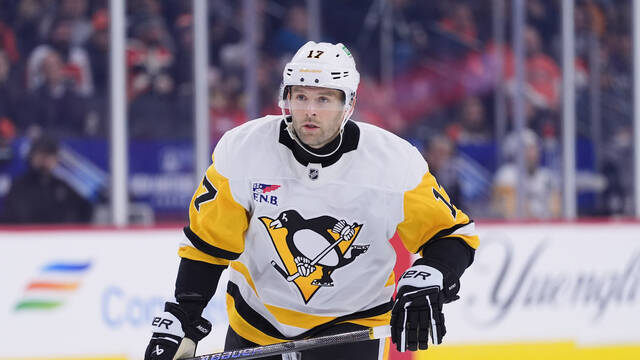During an early portion of the Pittsburgh Penguins’ recently completed training camp, third-year forward Anthony Angello overheard forward Brian Boyle, a veteran with 13 years of NHL experience on his resume, offer a broad observation.
“We stepped out there for a drill,” said Angello. “I was Boyle, myself and (forward Drew O’Connor) and (Boyle) goes ‘(Gosh darnit), this is a big line.’ ”
Considering the dimensions of Angello (6-foot-5, 210 pounds), Boyle (6-foot-6, 245 pounds) and O’Connor (6-foot-3, 200 pounds), it was an apt assessment. And it’s one that probably could not have been proclaimed about the Penguins for the past several years.
Upon the arrival of former general manager Jim Rutherford in 2014, the organization began to stress speed over size. That approach was amplified when Mike Sullivan took over as head coach in 2015 and to great success, as evidenced by the ‘16 and ‘17 Stanley Cup championship banners the organization owns.
Four years removed from their most recent championship, things are different. Ron Hextall is the general manager and Brian Burke is the president of hockey operations, each of whom have won championships elsewhere in the NHL deploying bigger lineups.
Today, the Penguins are bigger, albeit incrementally.
In addition to Angello, Boyle and O’Connor, the Penguins also have forwards Radim Zohorna (6-foot-6, 220 pounds) and Jeff Carter (6-foot-3, 219 pounds) in their fold. And at some point, Evgeni Malkin (6-foot-3, 195 pounds) will rejoin the team after recovering from offseason knee surgery.
“It’s probably the biggest group that we’ve had in Pittsburgh,” Sullivan said. “We’ve had some big players on different teams that we’ve had. But certainly, these are some of the biggest guys we’ve had in Pittsburgh for sure.”
With the exception of Carter, most of these forwards figure to fill bottom six – if not bottom three – roles with the Penguins to open the season. So they’re not exactly the focus of how the team will operate in 2021-22.
Angello cleared waivers Sunday, and Boyle was in training camp on a professional tryout. Meanwhile, O’Connor and Zohorna still are technically rookies after playing in a handful of games during the 2020-21 season.
But they stand out – literally – compared to the vast majority of players the Penguins have employed in recent years.
The NHL as a whole has largely gotten smaller since 2005 when rules were introduced to emphasize speed and skill over size and strength.
Carter was a rookie in 2005-06 and saw that change manifest itself.
“It’s definitely changed,” Carter said. “As a bigger guy now, you have to be able to move or else you’re going to be left behind. The game is a lot faster now. You just have to be able to read the game a lot quicker. Positioning, probably more so than when I came in, is huge now. There’s all these little guys kind of flying around. It’s a little more thinking than it used to be.”
The golden age for big men in the NHL was the late 1990s and early 2000s.
“The way the game is played today is very different than it was played in the (1990s),” said Sullivan, a 6-foot-2, 204 checking center in the 1990s and early 2000s. “There was a lot more clutching and grabbing. When you look at defensemen, for example, during that era, guys were big and strong. They were hard to battle through to get to pucks, to establish a forecheck, to get inside, to get to the net front. … It’s just the evolution of the game. Today, with some of the rule changes that have come into play, you can’t interfere as much.
“There are players that played back in that era that might struggle in this era. There were players in this era that might struggle in that era. It’s just the evolution of the game.”
One player who has clearly adapted is Boyle who has lasted more than a decade in the NHL at a size more suitable as a small forward in the NBA.
“I’ve tried to do my best to understand as much of the game as I can,” Boyle said. “I tried to be a factor in every game depending on the role and what I have to do. When I was coming up in high school and I got drafted (in 2003), being a bigger player was a huge advantage. That might have shifted a little bit. But I’ve never heard that (being big is a detriment). You hear that with the smaller guys. You hear that less now (with smaller players).
“At this point, if you can be effective on the ice, you’re going to get a chance. If you can continue to do it, you’ll play. If you can prove yourself every day, you have a good chance of sticking around.”
The Penguins have some bigger bodies entering the 2021-22 campaign. But they’re not on the roster simply because of their size.
“The good players, they figure it out,” Sullivan said. “They figure out how to play in the modern game and how to play to their strengths and how to leverage their strengths to have success.”
Notes: Defensemen Mark Friedman was fined 1,812.50 for spearing Columbus Blue Jackets forward Sean Kuraly during a preseason game on Saturday. … Season opening rosters must be finalized by 5 p.m. on Monday. … The Penguins had a scheduled day off on Sunday.








